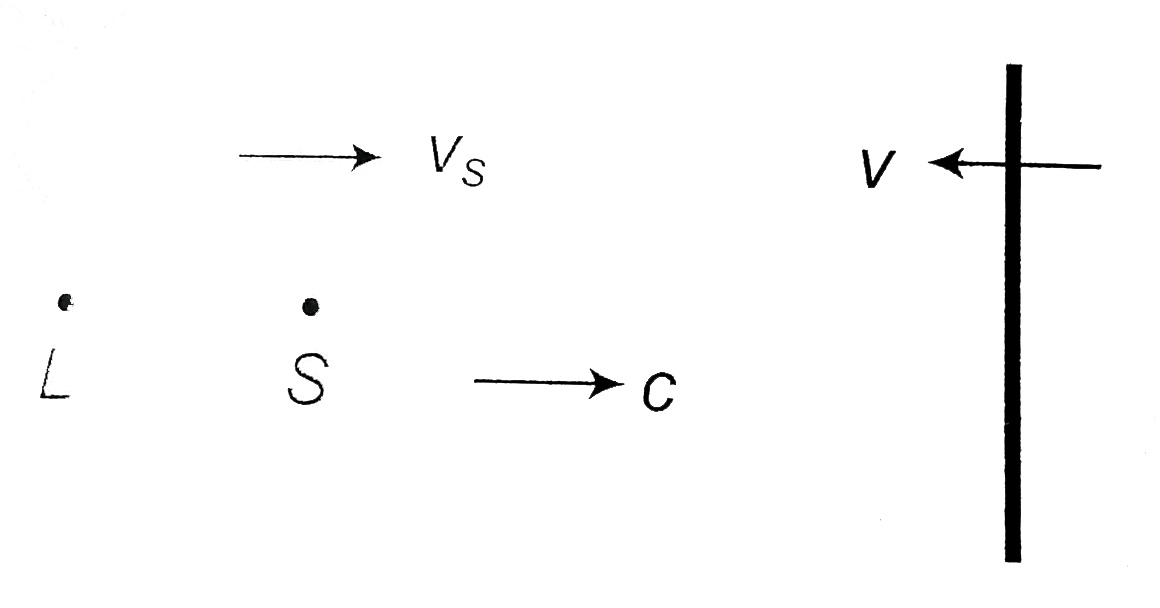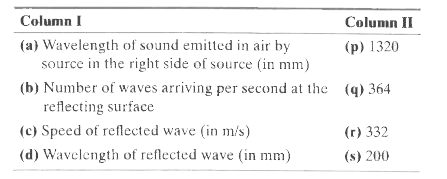A sound wave of frequency f travels horizontally to the right. It is reflected from a large vertical plane surface moving to left with a speed v. The speed of sound in medium is C
The frequency of the reflected wave is f(c+v)c−v
The wavelength of the reflected wave is c(c−v)f(c+v)
The number of waves striking the surface per second is f(c+v)c
The number of beats heard by a stationary listener to the left of the reflection surface is fvc−v
The correct Answer is:D

Frequency of reflected wave
fr=f(c+vc−v), (1) is O.K.
λr=cfr=c(c−v)f(c+v), (2) is O.K.
Frequency received at surface
f1=f(c+vc), (3) is O.K.
Statinoary listener L: Hw will receive f, directly, and f1 from surface (surface will act as source)
f'1=f1[cc−v]=f(c+vc−v)
Beat frequency =f'1−f=f[c+vc−v−1]
=f[2vc−v]=2fvc−v
(4) is wrong.
Topper's Solved these Questions
Similar Questions
A sound wave of frequency f travels horizontally to the right . It is teflected from a larger vertical plane surface moving to left with a speed v. the speed of sound in medium is c
(a) The number of waves striking the surface per second is f(c+υ)c
(b) The wavelength of reflected wave is c(c−υ)f(c+υ)
(c) The frequency of the reflected wave is f((c+υ))(c+υ)
(d) The number of beats heard by a stationary listener to the left of the reflecting surface is υfc−υ
View SolutionThe frequency of a source of sound is f. A sound wave from this source is moving horizontally twoards right. The wave is reflected from a large vertical plane moving towards left with a speed v.
The speed of sound in medium is C. Find the
(a) number of waves striking the surface per second.
(b) Wavelength and frequency of reflected wave.
(c) beat frequency.
View Solution
Knowledge Check
A sound wave of frequency f travels horizontally to the right. It is reflected from a large vertical plane surface moving to left with a speed v. The speed of sound in mwdium is C
A(a) The number of wave strinking the surface per second is f(c+vc)B(b) The wavelength of reflected wave is c(c−v)f(c+v)C( c ) The frequency of the reflected wave is f((c+v)(c−v))D(d) The number of beats heard by a stationary listener to the left if the reflecting surface is vfc−vA sound wave of frequency v travels horizontally to right. It is reflected from a large vvertical plane surface moving to the left with a speed v. The speed of sound in the medium is c, then
Athe frequency of the reflected wave is v(c+v)c−vBthe wavelength of the reflected wave is c(c−v)v(c−v)Cthe number of waves striking the surface per second is v(c−v)cDthe number of beats heard by a stationary listener to the left of the reflecting surface, is ∨c−v
A sound wave of frequency n travels horizontally to the right with speed with speed c. It is reflected from a broad wall moving to the left with speed v. The number of beats heard by a stationary observer to the left of the wall isAzeroBn(c+v)c−vCnvc−vD2nvc−v
A sound wave of frequency f propagasing through air with a velocity C, is reflected from a surface which is moving away from the source with a constant speed V. Find the frequency of the reflected wave, measured by the observer at the position of the source.
View SolutionA source of sound of frequency 1000 Hz moves to the right with a speed of 32 m/s relative to the ground. To its right is a reflecting surface moving to the left with a speed of 64 m/s relative to the ground. Take speed of sound in air to be 332 m/s.

View SolutionThe speed of sound wave in a given medium is
View SolutionA sound wave of wavelength λ travels towards the right horizontally with a velocity V. It strikes and reflects from a vertical plane surface , travelling at a speed v towards the left . The number of positive crests striking in a time interval of 3s on the wall is
View SolutionA sound wave of frequency f propagasing through air with a velocity C, is reflected from a surface which is moving away from the source with a constant speed V. Find the frequency of the reflected wave, measured by the observer at the position of the source.
View Solution
